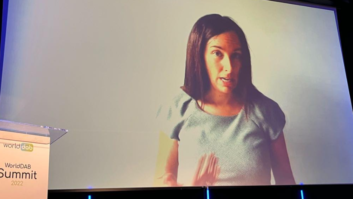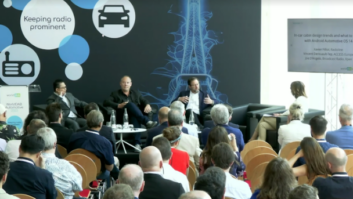What will car radios be like in the years to come? What role will they play in multimedia in-car entertainment/information systems, and what will this future look like? This topic was the last one tackled during the WorldDAB Automotive 2022 conference, which was held in person and online in London on June 22, 2022.
Betting Through Car Radio
Peering into his crystal ball, Radioline COO Xavier Filliol foresees in-car radio’s development going through three phases. “The first one is digitalization,” he said. “The second is interactions with podcasts.” And the third is direct interactive transactions between listeners and online business.
A case in point: Radioline is currently working to provision a software-based online betting icon on in-car radio systems. “The idea … is to be able to game and to bet on action for live sports events,” Filliol explained. But this version isn’t based on betting money: Instead, players bet in order to win free pizza.
In-car betting isn’t vaporware: “We are testing it with people and there is already one big major group in the U.S. that is interested,” he said. This approach could also be used for in-car “couponing, with ticketing, with so many possibilities.”
A Multimedia Experience for In-Car Kids
Developed by Folder Media, Fun Kids is a digital radio service carried on DAB throughout the UK. Today it is an audio service, but Matt Deegan, Folder Media’s Creative Director of Radio and Podcasting, sees Fun Kids expanding into a multimedia platform that will engage kids wherever they are.
Five to 10 years from now, Deegan expects Fun Kids’ audience to be “wearing Oculus Rifts (VR headsets) or having a version of that on a phone or a tablet,” he said. The challenge for Fun Kids will be to provide compelling in-car content “that’s probably free … to take our children from a journey that might start in the home, or home from school, into the car and onwards.”
[Related: “NAB, EBU Emphasize Carmaker Relationships“]
One thing is certain: To keep Fun Kids viable as a commercial entity, this content will have to be compelling and attractive to kids ages 6-11. These in-car consumers are “digital natives: They do not care what has been in the past. They do not care what a dashboard has previously looked like,” said Deegan. “They’re about the here-and-now and what’s available for them, and what they can do and what satisfies them.”
“What’s great about kids is they tell you exactly what they like and don’t like, and they don’t sugarcoat it,” he added. “They’ll turn something off and just move away to the next thing. They’re the most honest audience.”

Mind-Controlled In-Car Hybrid Radio
Jacqueline Bierhorst is Project Director at Digital Radio Netherlands. Asked about her take on in-car radio’s future, she observed that “vehicles and radio are approximately 100 years old and have been married ever since … What’s happening in the last couple of years, and the 10 years to come, is mind blowing.”
For instance, automakers and radio broadcasters are forming strategic partnerships with tech giants such as “Google, Amazon, Apple, and others,” said Bierhorst. And the advances being planned by these players are awe-inspiring: “At last year’s international show in Geneva, Mercedes even showed that they are now working on a concept car in which you could change radio stations, dim lights, or control navigation simply by thinking about it.”
When it comes to her own view of radio’s in-car future, Jacqueline Bierhorst foresees DAB+ and web-connected hybrid radio playing major roles in the dashboards of the future.
The reason? “Interoperability through DAB+ combined with IP, including metadata directly from the reliable source of the radio stations themselves, is easily available for all car companies,” she said.
The result? According to Bierhorst, “in the next one to three years, the radio experiences in all new cars should be hybrid FM, DAB+, and internet radio. This will be the ‘base radio’, the platform on which new features should be built and enriched with radio broadcasters’ podcasts, enhanced with brilliant visuals, (and) have perfect voice control: radio always plays what you ask for.”
“Radio will get personalized,” she concluded. “There will be different listening options for passengers and suggestions for content according to mood. And in the longer term with autonomous cars, radio will look even better, which could mean live video clips from studios, guest interviews, easier engagement in competitions or more commercial opportunities … and the sound quality will even be better and more enhanced.”












